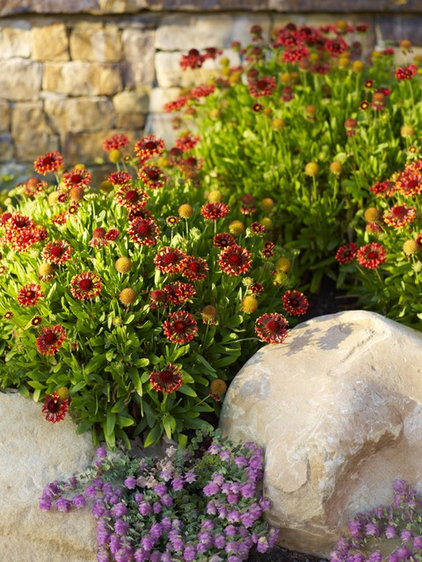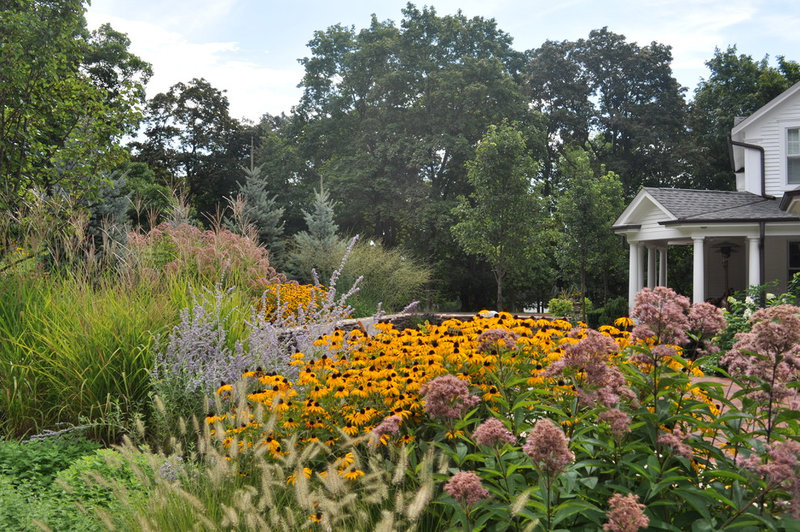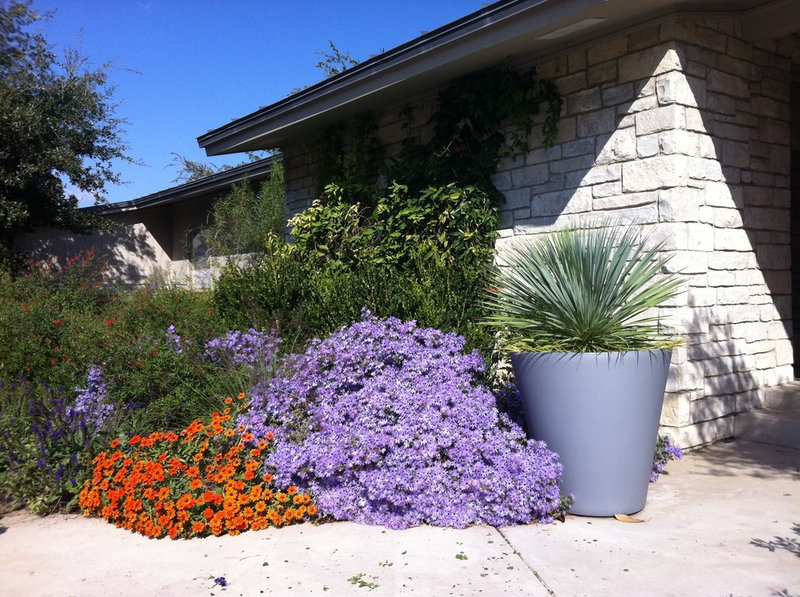 Toad Lily
Toad Lily(Tricyrtus hirta)
Although petite (about the size of a walnut), the orchid-like blooms of this Asian beauty are plentiful, nestled atop the plant’s graceful stems. Plant it near the front of borders or in containers where you can more easily admire the white, mauve or yellow blooms. Favorite varieties include ‘Miyazaki’, with its arching stems of purple-speckled flowers, and ‘White Towers’, which sports pure white blooms.
USDA zones: 4 to 9 (find your zone)
Light requirement: Full to partial shade (requires more shade in Southern areas)
Water requirement: Plant performs best in humus-rich soil that retains moisture. Tolerates wet soil.
Mature size: 1 foot to 3 feet
 Jay Sifford Garden Design
Russian Sage
Jay Sifford Garden Design
Russian Sage(Perovskia atriplicifolia)
Tall, shrubby Russian sage is a versatile, drought-tolerant and super-low-maintenance stunner that will bloom up to 15 weeks even in hot, sunny sites. It’s especially nice planted beside pathways where its fragrant flowers can be appreciated. Or use it to bring height, color and texture to a late-summer border. Great companion plantings include daylily, salvia, dianthus, Japanese anemone, boltonia, orange coneflower and sedum.
USDA zones: 4 to 9
Water requirement: Drought tolerant
Light requirement: Full sun
Mature size: 3 to 5 feet
 Jeffrey Gordon Smith Landscape Architecture
Blanket Flower
Jeffrey Gordon Smith Landscape Architecture
Blanket Flower (Gaillardia x grandiflora)
Named for its resemblance to the vivid woven blankets of the American Southwest, this flower cloaks the garden in yellow, burgundy or rich red from midsummer into fall. Blanket flower prefers fertile, well-drained soil, but it will tolerate poor, dry soil once established. Deadhead to keep the flowers coming. The dwarf, compact ‘Goblin’ cultivar is a favorite with its showy flowers and incredible bloom time. ‘Burgundy’ is another excellent choice that stands 2 to 3 feet tall with deep red flowers.
USDA zones: 3 to 10
Water requirement: Drought tolerant
Light requirement: Full sun
Mature size: 1 foot to 3 feet
 Shades Of Green Landscape Architecture
Japanese Anemone, Windflower
Shades Of Green Landscape Architecture
Japanese Anemone, Windflower(Anemone x Hybrida, Anemone hypehensis)
Native to Japan, this plant has lanky stems of semidouble flowers that add waves of pink or white to the late-season garden. A long-lived, fibrous-rooted perennial, Japanese anemone makes a stunning accent plant massed in borders or mixed with hostas or obedient plants. Prune after flowering to avoid prolific reseeding and dig around the roots to prevent unwanted spreading. Noteworthy varieties include the venerable ‘Honorine Jobert’ and the new dwarf Pretty Lady series (Anemone hupehensis) from Blooms of Bressingham.
USDA zones: 4 to 8
Water requirement: Prefers moderately moist to moist soil
Light requirement: Full sun to partial shade
Mature size: Up to 5 feet
 Pincushion Flower
Pincushion Flower(Scabiosa spp)
A nearly indefatigable bloomer, this easy-growing perennial produces lavender-blue, deep blue, white or pink flowers from an early Gainesville summer to early fall. It’s deer resistant and tough. The plant’s common name refers to its resemblance to small pincushions. For best effect, plant it in containers or in groups near the front of beds and borders. Deadhead for even longer blooming.
USDA zones: 3 to 11
Water requirement: Drought tolerant, though it prefers humus-rich, moist soil
Light requirement: Full sun. Can handle partial shade in the southern United States.
Mature size: 10 to 24 inches tall and wide
 Milieu Design
Black-eyed Susan, Orange Coneflower
Milieu Design
Black-eyed Susan, Orange Coneflower(Rudbeckia)
An all-American favorite, black-eyed Susan is beloved for its profuse flowering and easy growth. Ideal for informal, cottage and meadow gardens, this carefree perennial naturalizes beautifully and provides seed heads for winter interest. Among the top performers is ‘Goldsturm’, a reliable favorite with incredible staying power. Plant with purple Frikart’s aster or ornamental grasses for a glorious autumn display.
USDA zones: 3 to 9
Water requirement: Prefers plentiful water; drought tolerant once established
Light requirement: Full sun is best; tolerates partial shade
Mature size: 18 to 24 inches
More about growing black-eyed Susan
 Genevieve Schmidt
Perennial Sage
Genevieve Schmidt
Perennial Sage(Salvia X sylvestris ‘May Night’)
Most salvias give a lengthy performance in the garden, and cold-hardy ‘May Night’ delights with a late-season encore when regularly deadheaded. The plant’s indigo-blue spikes oflarge flowers attract butterflies and hummingbirds and make a no-fuss addition to beds and borders. Mix it with yellow flowers, purple sedums and lamb’s ears.
USDA zones: 4 to 9
Water requirement: Drought tolerant
Light requirement: Full sun
Mature size: 18 inches
 Fullmer's Landscaping, Inc
Obedient Plant, False Dragonhead
Fullmer's Landscaping, Inc
Obedient Plant, False Dragonhead(Physostegia virginiana)
Snapdragon-like spikes of clustered white, pink or magenta flowers distinguish this native plant, which derives its common name from the fact that its tubular flowers compliantly remain in whatever direction they are pushed. Be aware that this robust plant’s growing habits aren’t quite as manageable; it often multiplies quickly in the garden. Either plant it in Gainesville beds where it can spread to its heart’s desire or choose cultivars such as ‘Miss Manners’ or ‘Pink Manners’ that are bred to behave.
USDA zones: 3 to 9
Light requirement: Full sun to light shade
Mature size: 2 to 4 feet tall
 Yellow Corydalis
Yellow Corydalis(Corydalis lutea)
An incredible workhorse, carefree corydalis performs in even the most difficult growing conditions, including wet soil, dry shade and dense shade. This underused perennial produces fragrant clusters of soft yellow flowers on clumps of fernlike green leaves from late April to mid-October.
USDA zones: 4 to 9
Light requirement: Partial sun and shade
Mature size: 12 to 18 inches tall and wide
 Melissa Gerstle Design
Frikart’s Aster
Melissa Gerstle Design
Frikart’s Aster(Aster x frikartii)
For carefree summer-to-autumn color, few perennials can measure up to Frikart’s aster. Use it anywhere in borders or let it naturalize in prairie or meadow gardens. (Be sure to mulch the plant in winter in colder zones.) ‘Monch’ is one of the most gardenworthy aster cultivars, sporting an exuberant display of lavender-blue flowers from July to October.
USDA zones: 5 to 8
Water requirement: Prefers dry to medium soil; may rot over winter if the soil remains wet
Light requirement: Full sun
Mature size: Up to 3 feet tall and wide
More about growing asters | Gardening ideas for your region of the U.S.
